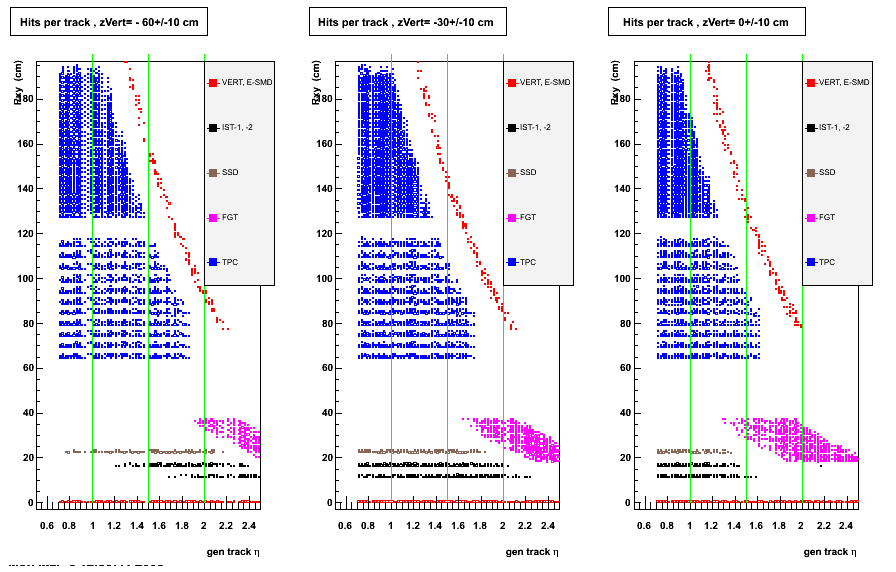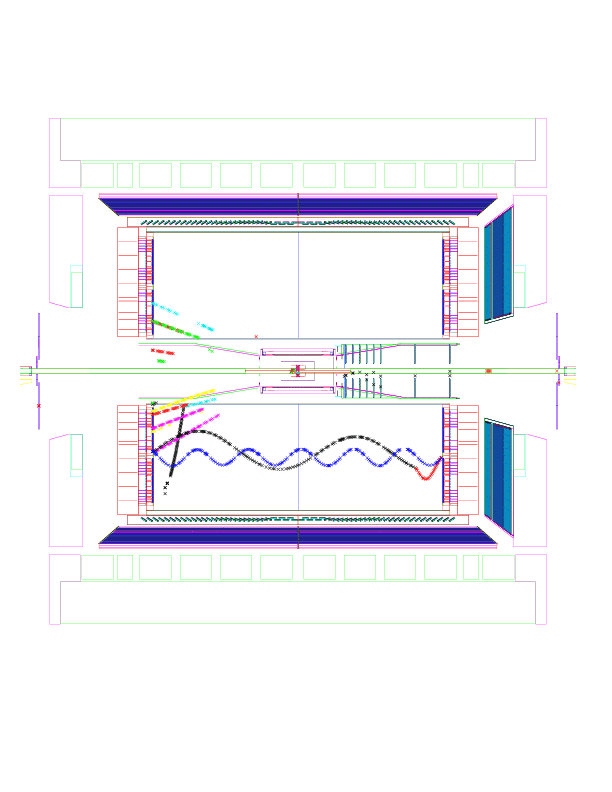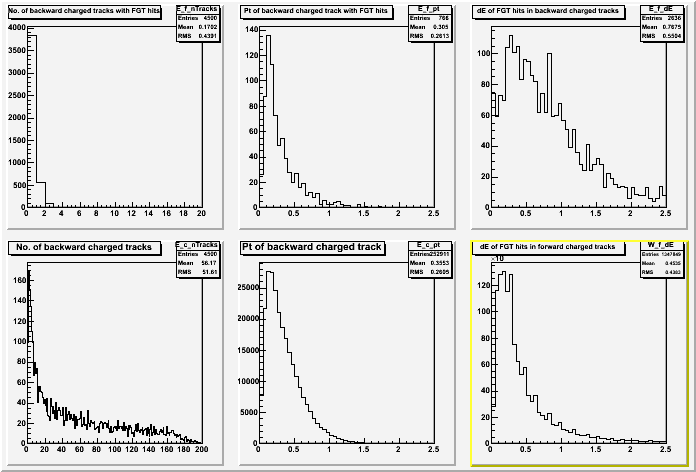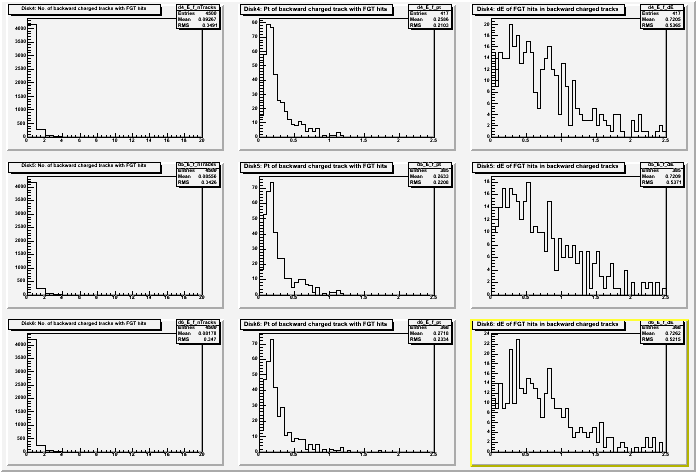FGT. . . . . . . . . . S I M U L A T I O N S
Simulation of physics background for development of e/h algo. ( Physics Background Simulation)
Selected topics:
- Method of Pythia event filtering using threshold on eta-phi grid (Practical Pythia Event Filter (Jan))
- List of available M-C event samples (Jan) ( W-events, QCD background events)
- PT scan of Pythia-filter rejection for QCD events ( Jan) of # of needed M-C events for LT=800/pb
- List of MIT Simulation Productions facility (by Mike)
- Pythia analysis version 1.0 (by Brian)
Physics Background Simulation
Ongoing effort of preparing physics-background samples for developing of e/h discrimination algos for W reconstruction
Existing Framework For FGT Simulations
With the completion of the FGT hardware review, focus must now be made on the creation and implementation of efficient analysis algorithms. To this end a framework for creating simulation files must be established. Here I document the existing framework I created this past summer for a small FGT project.
The creation of simulation files within STAR is handled in two steps.
- starsim is called with a PYTHIA kumac, creating a fzd file.
- The fzd file is converted to a full muDst with the bfc.
The kumac sets all parameters of the underlying physics events, while the bfc handles the fine tuning of the reconstruction of the STAR detector.
In the following analysis the simulation was split by the underlying physics processes: those producing W bosons and those from QCD 2->2 interactions. Both are produced with the geometry UPGR13 and sqrt(s) = 500 GeV, in accordance with the FGT upgrade. Moreover, each kumac accepts a random number seed to ensure that different jobs are independent of each other. Specific details are included below,
| W | Hadron | |
| Geometry | UPGR13 | UPGR13 |
| sqrt(s) | 500 GeV | 500 GeV |
| Vertex (mean, variance) | 0 cm, 60 cm | 0 cm, 60 cm |
| Subprocesses | 2, 15, 20, 23, 25, 31 | 11, 12, 13, 28, 53, 68, 96 |
| CKIN3 | 10 GeV | 10 GeV |
| CKIN4 | None | None |
| Additional Cuts | Require electron in the endcap with pT > 15 GeV | None |
| Additional Notes | W bosons made explicitly unstable | None |
| Events / Job | 4000 | 2000 |
| Cross Section / Job | O(103 pb) | O(103 pb) |
| PYTHIA + GSTAR + BFC Running Time / Job | O(20 hours) | O(16 hours) |
| PYTHIA + GSTAR Running Time / Job | O(12 hours) | O(6 hours) |
| Memory Used / Job | O(1000 MB) | O(1500 MB) |
| Size of Output Files / Job | O(2.5 GB) | O(2.5 GB) |
bfc.C\(1,nEvents,"trs ssd upgr13 pixFastSim Idst IAna l0 tpcI fcf Tree logger ITTF Sti StiRnd PixelIT IstIT StiPulls genvtx NoSvtIt SsdIt MakeEvent McEvent geant evoutgeantout IdTruth tags bbcSim emcY2 EEfs big -dstout fzin MiniMcMk McEvOut clearmem","fileName.fzd")
Detailed log files can be found at
/star/institutions/mit/betan/FGT/Logs/while the existing files are at
/star/institutions/mit/betan/ROOT_Files/FGT/Attached are the relevant scripts (the _.txt has been added to get around DRUPAL attachment restrictions), although the hardcoded paths are no longer valid. The master script is submit_simulations.csh, which submits all the others to the RCAS queue star_cas_big. In particular, W_job.csh and hadron_job.csh are each called with the command line arguments
*_job.csh <em>nEvents fileName randomNumberSeedThe *_job.csh scrips then call the starsim and bfc with the necessary arguments passed as appropriate.
Filtered Simulations For The Development of Electron/Hadron Discrimination Algorithms
Critical to the upcoming flavor physics at STAR is efficient electron identification in the endcap, particularly amongst the dominant charged hadron/meson background. The development of such discrimination algorithms, however, requires extensive simulations. To reduce the computational burden of these simulations to a practical level we must modify starsim, reconstructing only those events of interest.
In this case we require electrons and charged hadrons/mesons in the endcap, and by adding a filter to PYTHIA we can ensure that only events matching the this criteria are reconstructed. Below is a small study showing the significant reduction in computing time gained with this filtering.
The filtered simulations required a charged hadron or meson in the endcap with pT > 15 GeV before GSTAR was allowed to reconstruct the event. Candidate refers to an event meeting the above requirements in the PYTHIA record, and projected refers to an extrapolation estimate for 80 pb-1.
| Hadrons/Mesons | Filtered | Filtered (Projected) | Unfiltered | Unfiltered (Projected) |
| Candidates | 10 | 18,604 | 10 | 18,604 |
| Reconstructed GEANT Events | 10 | 18,604 | 2863 | 5,326,325 |
| Integrated Luminousity (pb-1) | 0.043 | 80 | 0.043 | 80 |
| Starsim Running Time (hours) | 0.274 | 509 | 7.42 | 13,817 |
| BFC Running Time (hours) | 0.845 | 1572 | 24.2 | 45,023 |
Looking at the tracks in the GEANT record we see that the filtering worked as described. Here every charged hadron/meson in every reconstructed event is shown, and in the Filtered sample we see a sharp cutoff at 15 GeV exactly as expected.

The same analysis can be done for the W boson simulations, here instead requiring an electron(positron) from a W decay in the endcap with pT > 15 GeV.
| Ws | Filtered | Filtered (Projected) | Unfiltered | Unfiltered (Projected) |
| Candidates | 10 | 672 | 10 | 672 |
| Reconstructed GEANT Events | 10 | 10 | 357 | 24,020 |
| Integrated Luminousity (pb-1) | 1.189 | 80 | 1.189 | 80 |
| Starsim Running Time (hours) | 0.0361 | 2.42 | 0.822 | 55.3 |
| BFC Running Time (hours) | 0.0882 | 5.93 | 2.807 | 188.8 |
Again, comparing the two files shows the desired effects

In both cases the computational demands seem impractical, but one has to remember that this extrapolation is based on the use of a single processor. Real jobs will be run in parallel, significantly reducing the projected times to more reasonable levels. Despite the reduction, however, it might still be necessary to reduce the desired integrated luminousity slightly.
Filtering PYTHIA Events In Starsim
Within the STAR framework, simulation files are created with the command starsim which runs both PYTHIA and GEANT. Unfortunately, this means that there is no straightforward way to filter PYTHIA events before the GEANT reconstruction and producing simulation files for rare events can be very time consuming, as most of the CPU is wasted on the GEANT reconstruction of undesired events.
The trick around this is to modify the PYTHIA libraries themselves. In particular we want to modify the PYEVNT subroutine which is run during the generation of each PYTHIA event. Begin by
- Checking out a copy of the pythia libraries from cvs
- Create a back up of pyevnt.F in case anything goes wrong
- Open up pyevnt.F in your favorite text editor
- Rename SUBROUTINE PYEVNT to SUBROUTINE PYEVNT_ORG
- Now create your own subroutine, SUBROUTINE PYEVNT
- Copy the variable declarations and commonblocks from the original PYEVNT
The body of this new subroutine will in general go as the following
while(conditions have not been met)
Call the original PYEVNT
Call any necessary auxillery subroutines
Loop over particles
if(not desired characteristic a) continue
if(not desired characteristic b) continue
...
if(not desired characteristic i) continue
Calculate relevant kinematic variables
Check conditions
Call PYLIST
Note that to avoid too many nested if loops we abort when the first test fails.
For example, consider an analysis requiring a high energy electron in the endcap. The usual PYTHIA settings allow one to require a high energy electron, but there is no way to restrict its location in the detector. So in the above pseudocode becomes
while(no high pT electron in the endcap)
Call the original PYEVNT
Loop over particles
if(not electron) continue
Calculate pT
Calculate eta
if(pT < 15) continue
if(eta < 1) continue
if(eta > 2) continue
return
Call PYLIST
The main background to the above is charged hadrons/mesons. In order to filter these we require that the particle has a charge of +/- 1, that is has the PDG ID of a hadron or a meson, that it has not decayed in the PYTHIA record, and fulfills the kinematic requirements.
while(no high pT jet in the endcap)
Call the original PYEVNT
Loop over the jets at the end of the PYTHIA record
if(not stable) continue
if(charge not equal +/- 1) continue
if(not hadron or meson) continue
Calculate pT
Calculate eta
if(pT < 15) continue
if(eta < 1) continue
if(eta > 2) continue
return
Call PYLIST
Once pyevnt.F has been succussfully modified it must be compiled with cons, and the path to the compiled library itself must be explicitly set in the kumac. For example,
gexec $STAR_LIB/libpythia_6410.somust be replaced by
gexec /star/u/username/path_to_directory/.slxx_gccxxxx/lib/name_of_new_pythia_library.soExamples of modified pyevnt.F files for both the electron example and the jet example are attached, as is a kumac for use with the jet example.
List of available M-C event samples (Jan)
.
M-C Event Samples Available
- General setup, assumptions
- use UPGR13 geometry
- run in SL07e
- use PPV vertex finder in reco
- displace & smear vertex in GEANT in X-Y plane: x0=+1mm, sig=200us, y0=-2mm, sig=200um (except setA)
- beam energy sqrt(s)=500 GeV
- detectors passed by track thrown at various eta at 3 Z-vertex location of -60, -30 an 0 cm.

- setA (produced by Mike @ MIT)
- setB (pilot sample by Jan @ RCF)
- setC - Pythia macros inspected by Jim: ppQCDprod.kumac & ppWprod.kumac
Filtering of Pythia events: seed cell =10GeV ET, pair of cells>20 GeV ET,
particle eta range [0.8,2.2], grid cell size: 0.14 in eta, 9 deg in phi
* setC1: /star/institutions/iucf/balewski/2008-FGT-simu/setC2-pt-0.2inv_pbThis is LT balanced for 0.2/pb, using your ppQCDprod.kumac
pt1 pt2 neve 10 ,15 ,373 15 ,20 ,1252 20 ,25 ,2516 25 ,30 ,3367 30 ,35 ,2330 35 ,40 ,1015 40 ,45 ,705 45 ,50 ,292 50 ,55 ,114 55 ,60 ,67 60 ,65 ,28 65 ,70 ,13 70 ,75 ,8 75 ,80 ,4 80 ,85 ,2 85 ,90 ,1 90 ,95 ,1
* setC2 (only filtered events of various types)

* setC3 (filtered vs. not filtered events)

* setC4 ( filtered QCD events w/ various partonic PT )

- setC5 : QCD events , 3-stage filtering, LT~100/pb

BFC w/ generic vertex finder has ~50% efficiency,
Vertex distribution: Gauss(Z=0, sigZ=60cm, Z=Y=0, sigX=sigY=0)
| Type of events | total events | time per event |
|---|---|---|
| Pythia, minB | 400K, 100 jobs | GSTAR: 8.4 sec, BFC ??? |
Files location: 80K eve at IUCF disk: /star/institutions/iucf/kocolosk/2008-02-15-fgt-hadron-background
full sample at MIT ...
Filtering of Pythia events: seed cell =10GeV ET, pair of cells>20 GeV ET,
particle eta range [0.8,2.2], grid cell size: 0.14 in eta, 9 deg in phi
BFC w/ PPV vertex finder has ~95% efficiency, SSD, STI not used in tracking
Vertex distribution: Gauss(Z=-60, sigZ=5cm, Z,Y offset)
Pythia event generator,
BFC chain:" DbV20080310 trs -ssd upgr13 Idst IAna l0 tpcI fcf -ftpc Tree logger ITTF Sti StiRnd -IstIT -SvtIt -NoSvtIt SvtCL,svtDb -SsdIt MakeEvent McEvent geant evout geantout IdTruth bbcSim emcY2 EEfs bigbig -dstout fzin -MiniMcMk McEvOut clearmem -ctbMatchVtx VFPPV eemcDb beamLine"
| Type of events | Pythia filter | total events | time per event | job name | file size, MB |
|---|---|---|---|---|---|
| W-events (kumac) | 1/6.5 | 1K, 1 job | GSTAR 10 sec, BFC 5.3 sec | wElec4 | fzd=149, stevent=132, geant=154, McEvent=132, muDst=14 |
| 1:1 , OFF | 5K, 1 job | - | wElec5 | - | |
| QCD-events (kumac) pt=20-30 GeV | 1/40 | 1K, 1 job | GSTAR 11 sec, BFC 6.7 sec | qcd2 | fzd=203, StEvent=157, geant=212, McEvent=172, muDst=17 |
| 1:1, OFF | 5K, 1 job | - | qcd3 | - | |
| QCD-events, scan pt 10...90 GeV | varies | 100 eve, 1 job | - | qcd_pt_xx_yy | files at ...balewski/2008-FGT-simu/setB-pt-scan/ |
Files location: /star/institutions/iucf/balewski/2008-FGT-simu/setB-pilot/
Custom code : Pythia, Generic Vertex finder, same location
evaluation of Pythia Filter for QCD & W events (setC3)
Based on setC3 the number of events with reco EM cluster ET>20 GeV is similar for the filtered and unfiltered pythia samples after LT correction - compare yellow & green areas:

------------ From Brian -------
Hi Jan,
I processed the events in setC3 and I put the plots into the
fgt-hn-contributions drupal page. (All plots show unfiltered events on
the left and filtered events on the right).
Transverse energy spectrum for the QCD events:
http://drupal.star.bnl.gov/STAR/system/files/ETspectrumQCD.png
Number of events passing ET>20GeV and ET>20GeV + Eta < 1.7 for QCD
events: http://drupal.star.bnl.gov/STAR/system/files/OPcountsQCD.png
Transverse energy spectrum for the W events:
http://drupal.star.bnl.gov/STAR/system/files/ETspectrumW.png
Number of events passing ET>20GeV and ET>20GeV + Eta < 1.7 for W events:
http://drupal.star.bnl.gov/STAR/system/files/OPcountsW.png
Brian
PT scan of Pythia-filter rejection for QCD events ( Jan)
Pythia Filer: cell>10 GeV ET, cluster >20 GeV ET , grid covers Endcap Pythia events

Note, 'live' spreadsheet is attached at the bottom
Examples of event filtering for some choices partonic PT ranges:
|
partonic PT 15-20 GeV Filter=1/760 |

|

|
|
partonic PT 40-45 GeV Filter=1/3.6
|

|

|
|
partonic PT 75-80 GeV Filter=1/4.6
|

|

|
Practical Pythia Event Filter (Jan)
Filtering of Pythia events preserving those which may fire HT trigger in the Endcap.
Motivation
In order to develop efficient e/h discrimination algo for reco of electrons from Ws it is necessary to generate sizable sample of QCD physics background events with 1e5 or more events triggering Endcap HT >10 GeV. The brute force approach (run PYTHIA+GSTAR+BFC long enough) is investigated by my not succeed due to low yield of events of interests.
Therefore, we are working on the in-fly Pythia events filtering. It must be more complex than accepting events with a single Pythia track above certain threshold because multiple tracks from jet (also hadrons) may deposit in a single tower cumulative energy exceeding the HT threshold even if all tracks have energy below this threshold.
The tricky part is to decide if EEMC response may be large before GSTAR does very time consuming simulation of EM & hadronic showers for the whole event.
Proposed Method (2-stage Pythia filtering)
- Define : eta range [0.9,2.1], partonPTthres of 5 GeV, jetPTthres of 5 GeV (to be tuned later)
- Inspect lines 7 & 8 of Pythia record (counting from 1) and drop event if none of partons is within eta range and above parton PT threshold.
For survived events - Define 2D eta-phi grid covering eta [0.9,2.1] and 2pi in phi. Divide it in to cells of size 0.1x0.1. Clear grid for every event.
- Loop over Pythia record 9..max and drop: partons, gluons, unstable particles, neutrino, muons.
Retain all stable hadrons, e+, e- within eta range, project particle ET in to the eta-phi grid. - find seeds all cells with ET above 1/2 of jetThreshold.
- for every seed from 8 pairs using every of its neighbors. If any pair ET sum is above jetThreshold event will be accepted and passed to GSTAR and eventually to BFC.
Additional comments:
* for Barrel eta range should be [-0.2,1.2] and cell size 0.05x0.05 in eta x phi.
* the code should be written in F77.
* at any step priority should be given to processing speed vs. program size. E.g. use lookup tables when reasonable.
* provide few QA histos generated with Pythia using HBOOK + kumac to display them
Content of Pythia record
1 proton 1 2 proton 2 3 parton from proton1 4 parton from proton2 5 parton from proton 1 after intial state radiation 6 parton from proton 2 after intial state radiation 7 parton 1 after scatter 8 parton 2 after scatter 9 ... intermediate and final partons/particles ....
evaluation of Bates minB sample (Jan)
Evaluation of minB events ample produced by Mike at Bates in January of 2008.
Events characteristic: Pythia MinB events, sqrt(s)=500 GeV, vertex Gauss(0,60cm)
Below you see detectors acquired by e+/e- surrogate :
1st pi-,pi+ with pT>2.0 GeV and eta>0.7
FGT disks are located at Z of 70,80,...,110 cm - our best guess location.
3 events samples were chosen based on Geant vertex location of -60, 30, and 0 cm, with margin of +/-10 cm, what leads to smeared FGT disks.

Optimization of FGT disk location
Several versions of FGT disk geometries has been studied in 2007
as documented here (disk-based HTML documentation)
Z disk location accuracy
Propagation of the Z hit location inaccuracy on to the error of predicted Rxy location of the Endcap EM shower.



geometry in MC
Documented evolution of implementation of FGT geometry in GSTAR, started on May, 2008
Our studies are below seen as child pages.
Here are links to other studies
- Weight of SSD componants (from survey), missing ladder weight in geant, total ~300g on West end, also: Jonathan
- SSD small end ring : Jonathan, total weight = 3416 g, missing in geant
- overview of Nonexistent node nid: 12480., Oct-2008, Christophe
1 content of UPGR15, May 2008
Selected cross sections of UPGR15 geometry, as of May 2008
Fig 1

Fig 2

Fig 3

Fig 4

Fig 5

Fig 5 Realistic geometry from Jim K. model, May 2008

2 UPGR15+FGT as of May 2008
UPGR15 geometry was modified to match best guess of FGT geometry as of May 2008.
The active FGT area is : Z1=70,..., Z6=120cm, DZ=10 cm, Rin=11.5cm, Rout=37.5 cm
There is 1cm of additional dead material at Rin & Rout
Fig 1. Zvertex=0 cm, green= eta [1.06,2.0]. , red=eta[2.5,4.0]

Fig 2. Zvertex=+30 cm, green= eta [1.06,2.0]. , red=eta[2.5,4.0]

Fig 3. Zvertex=-30 cm, green= eta [1.06,2.0]. , red=eta[2.5,4.0]

Fig 4. Zoom in on 1 FGT disk. Detected particle enters from the left, 'active' gas volume has depth of 3mm (between magenta ad blue lines), FGT strips collect charge on the 1st green line.
(units in cm)
Zstart = 70.0 ! starting position along Z axis
Z = { 0.0, 10.0, 20.0, 30.0, 40.0, 50.0} ! Z positions for GEM front face
FThk = { 0.05, 0.05, 0.05, 0.05 } ! foil thicknesses inside GEM
SThk = { 0.3, 0.2, 0.2, 0.2 } ! support/spacing thicknesses
SR = 1.0 ! radial size for support

USED material:
Fig 4b FGT disk front view in Geant

Fig 5. 1st FGT disk by Jim K. as of April, 2008


Fig 6. 3 FGT disks by Jim K. as of April, 2008

Fig 7 Realistic geometry from Jim K. as of May, 2008

Fig 8 Disk material budget, from Doug, as of May, 2008

Fig 9 APV location , from Doug, as of May, 2008

4 compare geom 2007 vs. UPGR16
Green dashed lines at eta=1.0,.1.06,2.0
red lines at eta=2.5, 4.0
geom=2007

UPGR16, geom=2010

Speculative FGT++
another 6 disks are added at the following Z:
Zstart = 62.98 ! starting position along Z axis
Z = { 5.4, 15.4, 25.4, 35.4, 45.4, 55.4, 75., 90., 105., 120., 135., 150.} ! Z positions of GEM front face
Green dashed lines at eta=1.0,.1.09,2.0
red lines at eta=2.5, 4.0

5 FGT cables in Geant
Notes,
If I want to know the total area for one FGT disk what is the proper multiplier : 4, 28, or 24*28 ?
Within the cable, multipliers for the individual "subcomponents" are in column L.
Then, there are overall 4 cables per FGT disk - the column B tells you number of cables and I-J tells you where they go.
In other words, for instance, overall total copper area in FGT-power cables is
24*(7*5.176E-3+1*3.255E-3) = 0.948 cm^2.
I know you asked to break out with one "line" per cable route - we can do this later but for now there are already a lot of lines... I'll leave them grouped as this and you should look at I-J to decide the lengths and where they are.
By the way, I imagine the "patch" between cone/FGT cables and "external" cables lying on TPC endwheel, through services gap, to crates, occurs somewhere just outside the cone, within the first foot or so.
6 radiation length study for UPGR16 + SSD
Study of the dead material in front and behind FGT.
3 versions of GEANT geometries were investigated:
- UPGR16 + current SSD w/ current cables
- UPGR16 w/ 'light' SSD (Alu support structure replaced by carbon, Cu cables replaced by Alu)
- UPGR16 without SSD, nor SSD cables
Plot below is just example of material using current SSD.

Many more plots are in attached PDF, in particular figs 2a-c, 3a-c, 4a-c.
7 PR track plots with UPGR16 & fixed barrel
Geometry= UPGR16, 6 FGT disks , fixed barrel geometry.
Single electrons, 20 GeV ET, thrown at eta=0, 0.4, 0.8, 1.2, 1.6, 2.0
Fig 1, Z vertex=0

Fig 2, Z vertex=+30 cm

Fig 3, Z vertex=-30 cm

FGT hits fired by backward tracks (Wei-Ming Zhang)
1, MC tracks (eta < -1.3) are thrown backwards and FGT are found fired.
Fig. 1, An events with FGT hits fired by backward tracks (UPGR16)

2, To investigate with tracks (1.3 |eta| < 3.1) from MC events of RQMD Au-Au 10 GeV
Fig. 2

There are two rows in Fig. 2. Each row has three plots, the left is track multiplicity of events, the middle pt of
tracks, and the right dE of FGT hits in KeV. The top row is plotted for backward tracks which fire FGT and for fired FGT
hits (backward hits). The first two of the bottom are for all backward tracks. The right of the bottom is a dE spectrum
of FGT hits fired by FORWARD tracks (forward hits). From Fig. 1, we see
1, A low level of backward hits (mult_0/mult_1 = 200 shown in the top left plot)
2, A relatively large energy loss of backward hits which is 2-3 time larger than that of forward hits.
This suggests backward tracks which fire FGT have very low speed and deposit more energy than forward MIPs.
Based on the above, we believe that backward hits in FGT come from multiple scattering.
Fig. 3, Split spectra of the top row of Fig. 2 for individual FGT disks: disk1 (top) disk2 (middle)
and disk3 (bottome)

Fig. 4, Split spectra of the top row of Fig. 2 for individual FGT disks: disk4 (top) disk5 (middle)
and disk6 (bottome)

